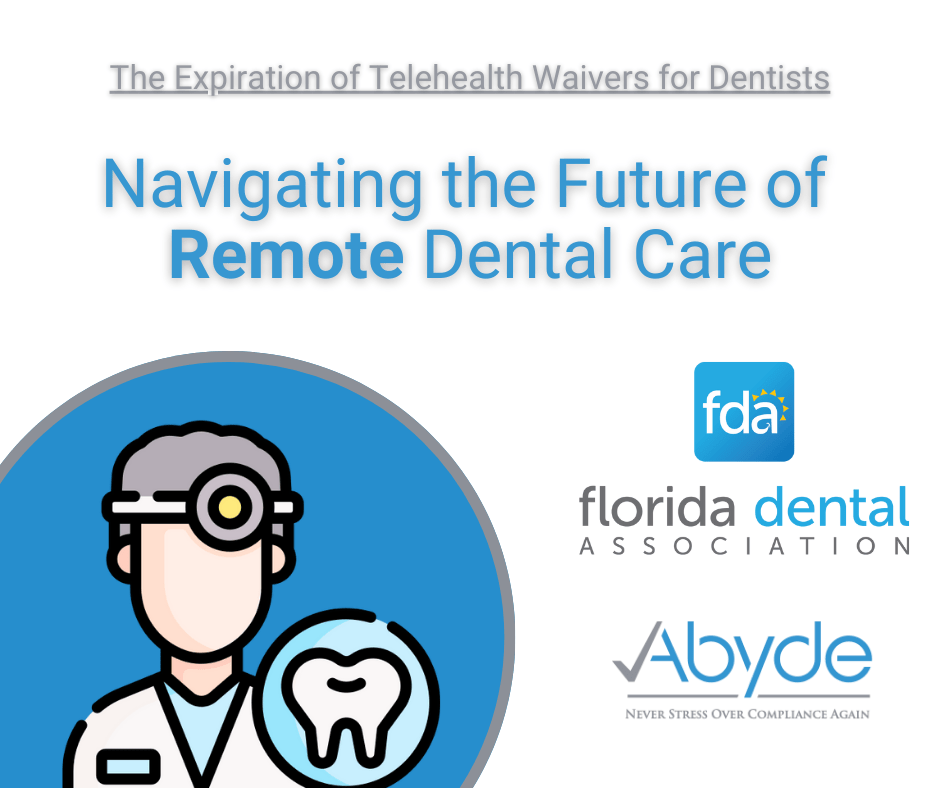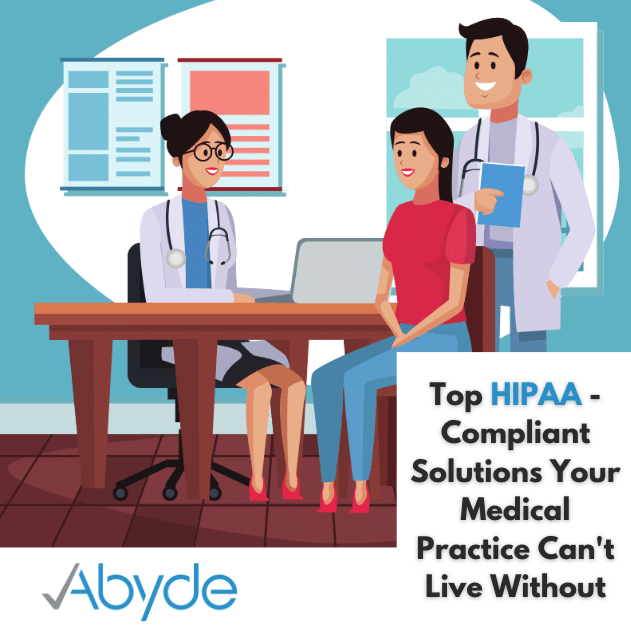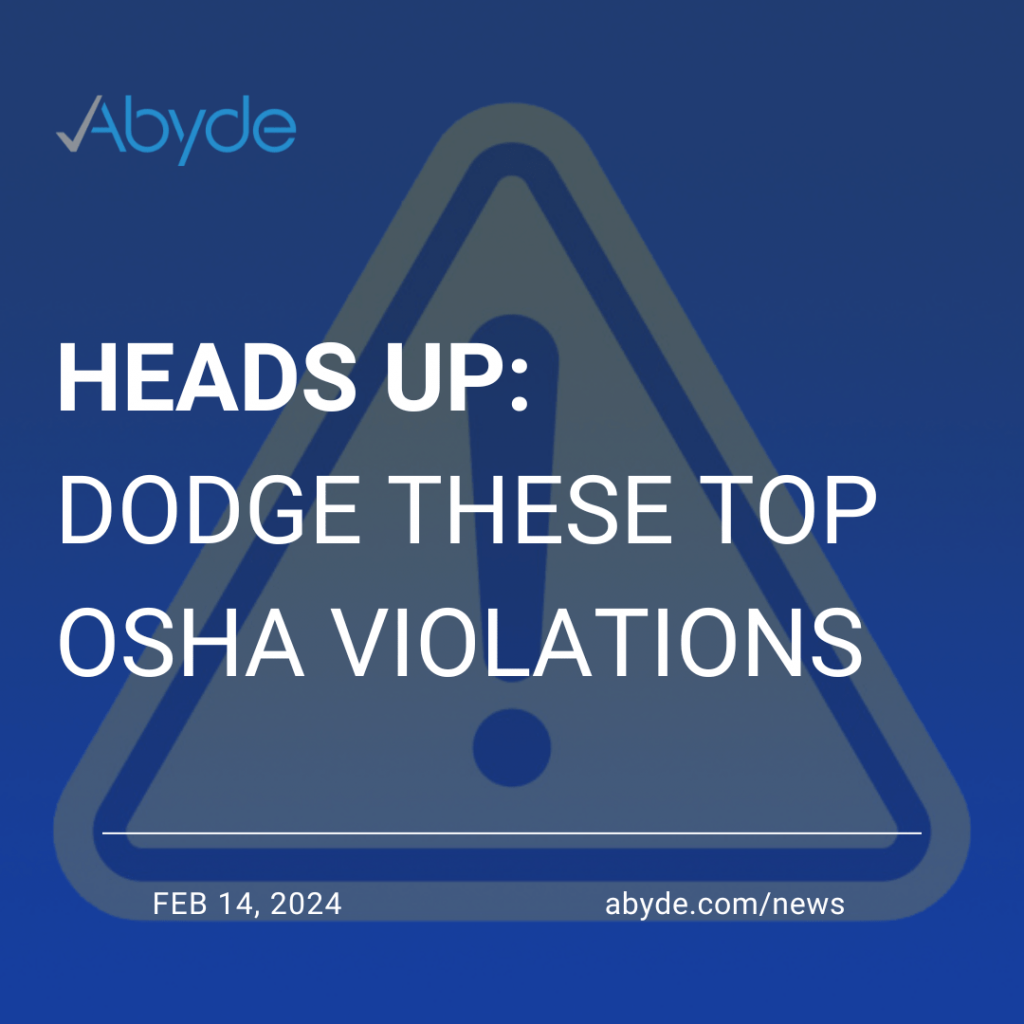June 30, 2023 Just as the American Revolution transformed history, a new revolution is taking place within workplace safety in healthcare. No need to dump tea in a harbor or worry about British troops; this time, it’s Abyde revolutionizing the power of Occupational Safety and Health Administration (OSHA) compliance with software that is empowering practices to ignite a safety revolution of their own. OSHA compliance software is leading the charge in transforming safety protocols, just as the American Revolution forever changed the landscape of nations. Declaration of Compliance Independence Similar to the Declaration of Independence, which boldly stated the rights and freedoms of the American people, Abyde’s OSHA compliance software established a new declaration of compliance independence for healthcare organizations. With its streamlined documentation and record-keeping capabilities, practices can be liberated from the shackles of manual paperwork. Digital tools enable the centralization of safety data, maintenance of accurate record keeping, and empowerment to exercise compliance efficiently and confidently. Safety Patriots OSHA is the king of workplace safety, but we’re not fighting it! Implementing OSHA compliance software creates a league of safety patriots within practices. Real-time monitoring and reporting features provide a vigilant eye on workplace safety, equipping organizations to identify and address hazards promptly. Revolutionary Training Camps OSHA compliance software like Abyde’s establishes revolutionary-battle-worthy training camps within practices. Comprehensive training modules and educational resources equip employees with the knowledge and skills to champion workplace safety. Ongoing training cultivates a sense of responsibility. It empowers employees to participate in their own safety actively. Regulatory Patriots The American Revolution fought against oppressive rule and unfair regulations. OSHA empowers organizations to become regulatory patriots. By automating the monitoring of regulatory changes and providing timely updates and notifications, Abyde ensures that practices stay informed and compliant. This ability to adapt and navigate the regulatory landscape helps practices avoid compliance lapses and assert their independence in maintaining a safe working environment. United Front During the American Revolution, unity was crucial for successfully crushing the British. Abyde’s OSHA compliance software fosters a united front for safety in healthcare. Collaborative tools within the software such as risk assessments, custom safety policy and procedure generation, record maintenance, and employee training enable seamless communication and coordination. This united front for safety ensures that every individual is invested in the well-being of their colleagues, just as the Americans did in pursuit of freedom. As the American Revolution paved the way for a new era of governance, Abyde’s revolutionary OSHA compliance software is transforming workplace safety practices in healthcare. Not by fighting a monarchy across the sea but by freeing organizations from the burden of manual compliance, OSHA revolutionizes safety in the modern workplace. Embracing the spirit of independence, practices can create an environment where safety is prioritized, accidents are minimized, and employees can thrive.
OSHA, Hurricanes, and Healthcare
June 22, 2023 Many of us are in the midst of yet another hurricane season. These tropical cyclones can blow healthcare safety plans straight into the eye of the storm. As such, it’s vital to understand and implement Occupational Safety and Health Administration (OSHA) safety guidelines to keep our healthcare facilities safe. Each year OSHA gears up, ready to guide healthcare workers through the challenges that storms can stir up. In healthcare during hurricane season, the term ‘all hands on deck’ is less of a naval cliché and more of an everyday reality. Hurricane Hygiene Hospitals and healthcare facilities are expected to be beacons of cleanliness. But when a hurricane is flinging everything from gators to garden gnomes, how can one maintain this? OSHA sweeps in with protocols for everything from biological hazards to chemical spills. They’ve got the full spectrum covered: personal protective equipment (PPE), cleaning protocols, and post-storm infectious disease prevention. Power Outages OSHA’s emergency response guidelines are there to protect medical practices in the eye of the storm. Backup generators are checked, and contingency plans are laid out. They’re ensuring medical machines keep humming and vital signs keep beeping even when the sun doesn’t shine. Evacuation Hurricanes are notorious for their grand entrances, sometimes making evacuation necessary for safety. In the midst of an already chaotic situation, evacuating a healthcare facility can be daunting. Thankfully, OSHA stepped in again with clearly outlined evacuation plans and meticulous headcounts. The aim? Safety, order, and zero left behind. Return After the storm has passed, there’s the matter of recovery and return. OSHA’s disaster recovery guidance guarantees that the process is safe and orderly. OSHA’s practical guidance on inspecting structural damages, identifying potential hazards, and safely resuming services transforms this monumental task into a systematic process that puts patients’ and healthcare providers’ safety first and foremost. Abyde It’s pretty apparent why healthcare organizations should abyde by OSHA regulations, especially surrounding hurricane season. Abyde’s software solution makes maintaining compliance a breeze – even when the hurricane winds are gusting. Are you ready to make healthcare compliance stress-free, even in the face of a storm? Don’t weather it alone. Embark on your journey with Abyde today, and let us steer your practice to the tranquil shores of compliance.
Ensuring a Healthy and Safe Medical Environment: The Importance of OSHA Compliance in Small to Midsize Medical Practices
June 1, 2023 When thinking about medical practice compliance, the first thing that likely comes to mind is HIPAA, patient confidentiality, and related healthcare regulations. While these areas are undeniably crucial, there’s another regulatory authority that should never be overlooked, even in the smallest of medical practices: the Occupational Safety and Health Administration (OSHA). OSHA sets and enforces standards that help manage these hazards and provide safe working environments. But why is OSHA compliance so essential for small to midsize medical practices? A Culture of Safety OSHA compliance is not just about following regulations—it’s about creating a culture of safety. This promotes a sense of well-being among employees, which, in turn, fosters better patient care. Studies have shown that safe, happy employees are more engaged and productive, which is essential in a patient-centric industry like healthcare. Protection Against Occupational Hazards Medical professionals are exposed to an array of occupational hazards. OSHA standards aim to protect employees from potential threats such as exposure to infectious diseases, hazardous drugs, ionizing radiation, and more. By complying with OSHA standards, small to midsize medical practices can ensure the well-being of their staff, leading to reduced absences, lower turnover, and increased employee satisfaction. Legal and Financial Implications Non-compliance with OSHA regulations can lead to hefty fines and legal consequences. Small to midsize practices might not have the financial resilience to deal with such penalties, which can range from thousands to hundreds of thousands of dollars. Additionally, non-compliance can result in lawsuits, tarnished reputation, and even closure of the practice. Maintaining Trust Patients entrust healthcare providers with their lives and well-being. If a medical practice fails to comply with OSHA regulations, it can significantly damage the trust built between the healthcare provider and their patients. Adherence to OSHA standards sends a clear message to patients that their safety, as well as the safety of the staff providing their care, is a top priority. Staying Ahead of Changes Healthcare is an ever-evolving field with new technologies, treatments, and threats emerging regularly. OSHA compliance ensures that medical practices are staying ahead of these changes, preparing for new hazards, and continuously improving their safety protocols. In conclusion, the importance of OSHA compliance in small to midsize medical practices cannot be overstated. It fosters a culture of safety, protects against occupational hazards, saves potentially significant legal and financial costs, maintains patient trust, and keeps the practice prepared for changes. Given the high stakes of medical care, these benefits show why OSHA compliance should be seen as a non-negotiable element of running a successful, responsible, and trustworthy medical practice. Abyde’s software offers a comprehensive solution that helps small to midsize practices manage their OSHA compliance needs effectively. The platform delivers continuous updates in line with OSHA changes and standards, provides training for employees, and includes risk analysis features. In doing so, it minimizes the potential for costly penalties while allowing healthcare providers to focus on what they do best: providing top-quality care for their patients. Investing in OSHA compliance is an investment in the well-being of your staff, your patients, and the long-term success of your practice. Choose Abyde today, and step into a future where regulatory compliance and optimal patient care are completely stress-free.
The Expiration of Telehealth Waivers for Dentists: Navigating the Future of Remote Dental Care
May 23, 2023 Over the past couple of years, telehealth has revolutionized the healthcare industry, including dentistry. However, as the COVID-19 pandemic wanes and the healthcare landscape evolves, the telehealth waivers that allowed dentists to provide virtual care through non-compliant platforms are expiring. Let’s explore the implications of these expiring waivers and how dentists can navigate the future of remote dental care. The Rise of Telehealth in Dentistry: Telehealth emerged as a crucial tool during the pandemic, enabling dentists to connect with patients remotely for consultations, follow-ups, and non-emergency care. These waivers expanded access to dental services, particularly for underserved populations, reduced unnecessary in-person visits, and improved overall patient experience. Dentists embraced telehealth to ensure continuity of care while minimizing the risk of virus transmission. Implications of Expiring Waivers:Using platforms like Apple Facetime, Skype, Zoom, and other non-public facing platforms were part of the Notice of Enforcement Discretion the OCR laid out in March of 2020. Now that virtually every EHR/PM solution and other technologies have emerged over the last 3 years, practices can easily implement compliant solutions. Dentistry will always predominantly be an in-person health care service but with the expiration of telehealth waivers, those dentists that found telehealth an important addition to their practice need guidance on which compliant platforms to use. Dentists must evaluate the effectiveness, efficiency, and patient satisfaction associated with virtual care. Additionally, they should consider the legal and regulatory implications of providing telehealth services without waivers and adapt their practices accordingly. Navigating the Future of Dental Care: To navigate the post-waiver landscape, dentists can take several steps. First, staying informed about the evolving guidelines and regulations surrounding telehealth is crucial. • The first step is assessing risks and vulnerabilities through a Security Risk Analysis. This knowledge will help dentists adapt their practices and comply with existing laws. • Second would be to have policies in place to ensure the telehealth services these dentists provide to patients is telling the story of how they are protecting that sensitive patient information. • Finally, investing in technology and software solutions that facilitate secure and efficient virtual consultations can enhance the patient experience and practice efficiency. Conclusion: While the expiration of telehealth waivers poses challenges for dentists, it also presents an opportunity to evaluate and refine the role of telehealth in dental care. By staying informed, embracing hybrid models, and leveraging technology, dentists can continue to provide high-quality care while adapting to the evolving healthcare landscape. Questions regarding HIPAA and OSHA Compliance, please email Abyde at info@abyde.com or call (800) 594-0883
Top HIPAA Compliant Solutions Your Medical Practice Can’t Live Without
May 2, 2023 The Health Insurance Portability and Accountability Act (HIPAA) was enacted in 1996 to enhance privacy and security in the healthcare sector. One of the key provisions of this legislation is the need for healthcare organizations, including independent medical practices, to protect the privacy and security of their patient’s health information. As a result, HIPAA software solutions have emerged as crucial tools for ensuring compliance and safeguarding sensitive data. In this article, we will explore why HIPAA software solutions are essential for independent medical practices. • Efficient Management of Patient Data Independent medical practices typically handle a significant amount of sensitive patient data, ranging from medical histories and diagnoses to billing information. HIPAA software solutions streamline the management of this data by providing an organized, secure platform for storing and accessing patient information. This improves efficiency and helps medical practices comply with HIPAA’s Privacy and Security Rules, which mandate strict controls over the use and disclosure of protected health information (PHI). Recommended Companies; • Enhanced Data Security Data breaches are an ever-present threat in the healthcare sector. They can lead to significant financial and reputational damage, not to mention the harm caused to patients whose information is compromised. By implementing network and database security solutions, independent medical practices can significantly improve the protection of their data. These solutions often come with robust encryption, access controls, and audit trails, which help prevent unauthorized access and ensure compliance with HIPAA’s Security Rules. Recommended Companies; • Minimizing the Risk of Non-Compliance HIPAA non-compliance can result in severe penalties, including hefty fines and criminal charges. For independent medical practices with limited resources, the costs of non-compliance can be particularly devastating. However, HIPAA risk management software solutions help practices navigate complex regulations and maintain compliance by providing the documentation necessary to prove compliance, training modules, and regular updates that reflect changes in federal and state laws changes. Recommended Companies; • Streamlined Workflows and Improved Patient Care By automating many tasks associated with managing patient data, HIPAA software solutions that improve processes can help independent medical practices save valuable time and resources. This enables healthcare professionals to focus more on providing quality care to their patients. For example, software solutions may include features such as appointment scheduling, electronic prescription management, and secure messaging, which streamline workflows and improve patient-provider communication. Recommended Companies; • Storing and Transmitting Patient Images and Data Data sharing in a compliant manner ensures it’s secure, efficient, and getting into the right hands. Having HIPAA-compliant solutions that provide a forum to share patient data and images easily can help providers quickly get the important details needed to provide next-level care to patients. The other side to this critical point is the patient experience. As patients are increasingly concerned about the privacy and security of their health information, allowing patients to access their data without barriers while being secure is a great way to build trust between patients and providers. Recommended Companies; In Summary HIPAA software solutions are an indispensable asset for independent medical practices, offering numerous benefits ranging from improved data management to enhanced security and compliance. By leveraging these solutions, healthcare professionals can focus on their primary mission—providing quality care to their patients—while ensuring that they are operating within the confines of the law. In an increasingly competitive healthcare landscape, independent medical practices cannot afford to overlook the importance of HIPAA software solutions in safeguarding their patients’ information and maintaining their reputation.
ChatGPT & HIPAA: A Quick Guide on What You Need to Know
April 26, 2023 If you haven’t heard about ChatGPT over the last few months, you might still be Googling everything! ChatGPT launched in November 2022 and has taken the internet by storm. Developed by OpenAI, using artificial intelligence (AI) technology, it can have human-like conversations while giving you all the details of whatever you may ask it. So we haven’t seen it be able to make you dinner just yet. Still, it has successfully written computer programming, passed a series of different exams, and written entire feature-length articles. (Wow, I feel like a doting parent!) AI language models are transforming how we approach everyday tasks or complete major projects, and the healthcare industry has even jumped on board the ChatGPT train. ChatGPT has assisted in scheduling appointments, treatment plan assistance, patient education, medical coding, and more! While this all sounds exciting and has the opportunity to improve patient care, protecting your patient’s data when using these types of tools will be imperative and should be approached with caution. So what are some of the red flags to be aware of when it comes to HIPAA compliance: • At this time, OpenAI does not sign a Business Associate Agreement. Therefore, it is not HIPAA compliant. HIPAA regulations require that covered entities only share PHI with vendors who have signed a BAA. This ensures that PHI is protected and that all parties comply with HIPAA laws and regulations. Prior to implementing any AI technology that processes or accesses PHI, covered entities must enter into a business associate agreement with the vendor of such technology. • Protect PHI when using the chat platform. OpenAI warns against inputting confidential information into the platform. As with many technology platforms, ChatGPT collects information and reviews conversations to improve systems and services. In other words, there is no telling where that data is being stored and, therefore, cannot be protected. Because this platform is not HIPAA compliant, it’s super important to remember not to input any identifiable patient information. When working with PHI, de-identifying or anonymizing data is key to minimizing the risk of a data breach. • Establish access controls and monitor chat logs. To minimize risk, access to chat logs should be restricted to those who need it as part of their job function. Don’t forget to implement written documentation of which employees can access chat logs, and be sure to revoke access if necessary. These chat logs are highly recommended to be monitored and audited to ensure they do not contain any PHI. • Establish Policies and Procedures and train employees. When implementing a new technology, such as ChatGPT, that potentially accesses PHI, policies, and procedures must be implemented to ensure that all appropriate safeguards are in place to support the use of the new technology. Training employees on properly using new technology is also super important. Training should include security best practices, data privacy importance, and incident reporting steps if necessary. • Create and implement an incident response policy. As with any security risk, having an incident response policy is super important to help mitigate risk in the case of a breach. This plan should include procedures for identifying and mitigating the incident, notifying affected individuals, and investigating the cause of the incident to prevent future incidents. By proactively prioritizing patient privacy and security, healthcare organizations can greatly benefit from ChatGPT and other AI language models. Streamlining administrative work and improving patient outcomes, sounds like a win-win. But, it’s critical that you carefully balance increased efficiency and elevated risks related to patient data privacy. This is new for everyone, so not making drastic changes to your business because of something ChatGPT can do should be considered. Your patients still want human experiences, and that is something ChatGPT can’t take away from you and your staff!How can you stay up to date on the latest compliance trends and news? Contact our compliance experts at Abyde today for guidance on this everchanging technical landscape and see how we can help you be successful in the years ahead! To book a demo with one of our Abyde specialists, click here or call us at (800) 594-0883
A Culture of Compliance – Your Get Out of Jail Free Card
April 18, 2023 Everyone wishes for the “Get Out of Jail Free” card in the game of Monopoly, so you can sell it and make money or free yourself from the slammer and continue your quest for wealth. But don’t you wish you had a card like this in real life so you could avoid paying a late fee, get out of an awkward situation, or get out of a speeding ticket? Imagine handing a police officer the card with your license and registration, I bet you would get a good chuckle! When it comes to healthcare compliance, demonstrating “good faith” could provide you with that much-needed “Get Out of Jail Free” card if you are investigated, audited, or are facing a violation. “Good faith” generally means that you have made a sincere and honest effort to comply with applicable laws, regulations, or standards pertaining to HIPAA and OSHA. So what do regulators look for when determining whether or not a practice has demonstrated “good faith”? First, you have implemented policies and procedures to include applicable forms or required logs. Next, staff has been trained in accordance with HIPAA and OSHA timeframes and requirements. And most importantly, whether or not you have completed a HIPAA Security Risk Analysis and OSHA Facility Risk Assessment that have identified risks, hazards, and mitigation efforts. While regulators may consider other factors, implementing a documented compliance program suggests you are committed to compliance and taking reasonable steps to protect your patients’ PHI and provide a safe and healthy workplace for staff. It is important to keep in mind “good faith” does not guarantee immunity from regulators. Every situation will have different mitigating factors, such as malicious intent or an identified hazard that went unmitigated. While you may be promoting a culture of compliance, ignoring the blatantly obvious could lead to you losing that “Get Out of Jail Free” card. Okay, how can you win at the HIPAA and OSHA compliance game? While it may be difficult to achieve compliance perfection, having a documented culture of compliance and, even more importantly, not letting your compliance program lapse will be key. These moves will show your “good faith” effort towards safeguarding patient information and employee safety and might even earn you the jackpot or a luxury Dark Blue property (IYKYK).
Heads Up: Dodge These Top OSHA Violations!
February 14, 2024 Hey there! Ever heard of OSHA? Think of them as the workplace safety cheerleaders, ensuring everyone stays healthy and happy at work. Ensuring a safe and healthy workplace is paramount for our heroes on the frontlines. Let’s delve into the top OSHA violations to see what you need to avoid and prioritize workplace safety: Bloodborne Pathogen Management: Proper handling of blood and bodily fluids is crucial, with appropriate PPE and training mandated for everyone’s protection. Respiratory Protection: Implement proper respirators and ventilation systems to safeguard staff from airborne contaminants and ensure optimal respiratory health. Personal Protective Equipment (PPE) Utilization: Equipping everyone with the correct PPE and ensuring its proper use and maintenance creates a vital barrier against workplace hazards. Recordkeeping Meticulousness: Maintaining accurate and timely records of injuries, illnesses, and safety hazards facilitates proactive risk identification and mitigation strategies. Lockout/Tagout Procedure Implementation: Prevent accidental equipment activation by strictly adhering to established lockout/tagout procedures during maintenance activities. Remember, adhering to these guidelines fosters a safer and healthier environment for everyone, ultimately contributing to a thriving healthcare ecosystem. Let’s prioritize safety and empower your practice to shine! Thankfully, Abyde can help your practice avoid these common OSHA violations. Our revolutionary OSHA for Healthcare software includes entertaining training, dynamically generated documentation, a thorough facility risk assessment, and much more! To learn more about how you can simplify your practice’s compliance, contact us at info@abyde.com and schedule a demo here.
Outsourced Doesn’t Mean Overlooked
January 26, 2023 We get it. The hiring market is tough out there right now and when your main goal is providing the best experience for your patients, you will do whatever it takes to build a strong team. But before you go sailing the high seas to find your next hire, you might want to make sure they’re paddling in the same direction. Are you considering outsourcing job roles to agencies that employ individuals in other countries? A company’s location and where its employees are located doesn’t necessarily mean they are or are not HIPAA compliant. As a practice, you are responsible for checking the company’s policies and procedures of any company you hire to ensure that they comply with all relevant regulations. If an organization outsources any function that involves access to PHI, it must have a written contract with the Business Associate. Here are some questions we recommend asking prior to working with an outsourced company: Let’s make sure all eyes are on the same prize – HIPAA compliance. Still not sure if you’re asking the right questions? Give us a buzz and we will walk you through the most important processes and policies to follow.
Brushing & Flossing Are Important to Your Practice, Too
January 19, 2023 You know the drill, no pun intended. The hygienist finishes a cleaning and hands the patient their goody bag full of all the fun things, including a toothbrush and dental floss. While this has become the norm for the practice and the patient, there is a good reason for it. Hygienists are taught to preach good oral hygiene, and it’s no secret that most patients that brush and floss regularly will experience better oral health and require less invasive treatment down the road. But what about those patients who don’t follow the advice or over time fall out of best practice? Yes, we’re looking at you, guy who only flosses the night before their appointment. The patient is typically aware of their intermittent compliance but since they are asymptomatic, they continue hoping for the best and vow to do better after the next cleaning. Then as it usually does, life happens and they cancel their next cleaning. And with the best of intentions, they plan to reschedule but keep forgetting. Disease begins to take hold. If the patient is fortunate, they return to the office before the issue is too serious and it can be resolved with a relatively simple treatment plan. Those less fortunate may require more involved and expensive procedures. So you’re probably wondering by now, how does any of this tie back to Abyde, a healthcare software company? Well, we’ve brought in one of our Abyde Ambassadors to tie it all together. Michael Wilgus shares his experience from the last 20 years in the industry. “Ironically, I have seen a similar scenario in hundreds of practices regarding HIPAA and OSHA compliance. A practice starts out with positive intent and implements what they believe is a strong and complete compliance program. Things get busy, there is turnover, and compliance gets pushed to the back burner. When violations or inspections occur (because they are not an if situation), they are usually due to a knowledge gap or are accidental, and may even be asymptomatic to the practice owner.” With HIPAA, if an event is reported, the Office of Civil Rights (OCR) may choose to implement a corrective action plan (think treatment plan) for the practice. That plan can be expensive, time-consuming, and involve an OCR specialist monitoring your progress regularly for an extended period. The U.S. Department of Labor isn’t missing out on the fun either. They are actively ramping up their OSHA program by hiring more investigators and estimate their budget to increase by 14.7%, going from $612 Million in the fiscal year 2022 to $701 million in 2023. The average penalty levied on a dental practice in 2022 for a HIPAA violation was measured in the tens of thousands of dollars; one estimate shows it to be approximately $45,000. Sacrificing the net revenue from months’ worth of crowns is something most practices cannot afford. When it comes to OSHA, the punch-to-the-gut penalties are nothing to chuckle at. And let’s not forget the recent increase in these dollar amounts. Achieving and maintaining compliance when using services from Abyde takes less time than a patient should spend brushing and flossing, and if we can humble brag for a minute – we make it easy and fun! Brushing and flossing are not only good for your patients but are also good for your practice. Ready to get your practice’s compliance hygiene up to par?









